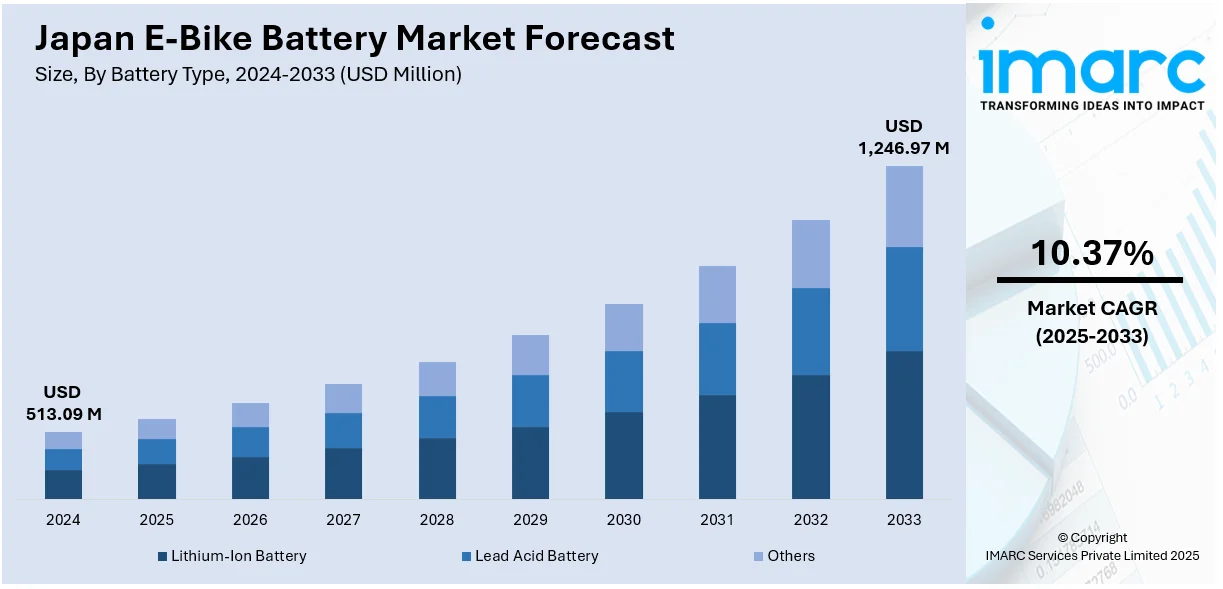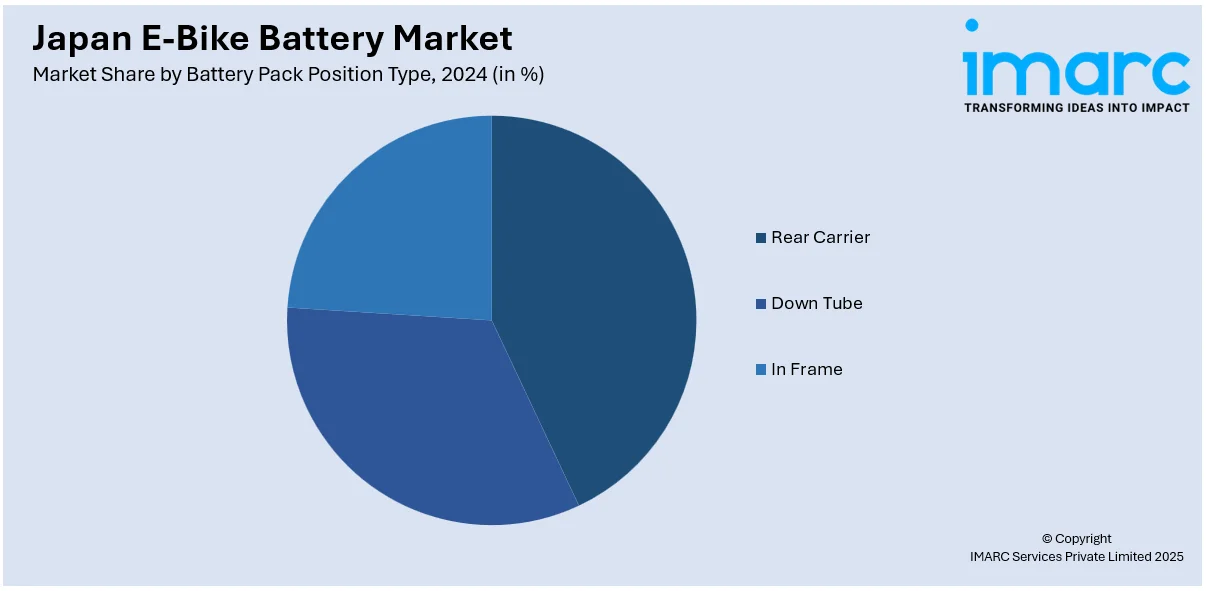
Japan E-Bike Battery Market Size, Share, Trends and Forecast by Battery Type, Battery Pack Position Type, and Region, 2025-2033
Japan E-Bike Battery Market Overview:
The Japan e-bike battery market size reached USD 513.09 Million in 2024. Looking forward, IMARC Group expects the market to reach USD 1,246.97 Million by 2033, exhibiting a growth rate (CAGR) of 10.37% during 2025-2033. The integration of advanced battery management systems (BMS) and the growing adoption of e-bikes for urban mobility are pivotal factors driving the e-bike battery market. BMS technology optimizes battery safety, efficiency, and lifespan, while e-bikes offer an eco-friendly and effective transportation alternative for urban areas. This shift towards eco-friendly, convenient travel is increasing the Japan e-bike battery market share.
|
Report Attribute
|
Key Statistics
|
|---|---|
|
Base Year
|
2024 |
|
Forecast Years
|
2025-2033
|
|
Historical Years
|
2019-2024
|
| Market Size in 2024 | USD 513.09 Million |
| Market Forecast in 2033 | USD 1,246.97 Million |
| Market Growth Rate 2025-2033 | 10.37% |
Japan E-Bike Battery Market Trends:
Advances in BMS
The incorporation of sophisticated BMS is significantly contributing to the expansion of the e-bike battery market in Japan. BMS technology manages essential aspects, such as charging cycles, temperature, and general battery health, guaranteeing the safety, durability, and peak performance of e-bike batteries. By reducing risks like overheating, overcharging, or battery malfunction, BMS offers users safer and more dependable e-bike experiences. Moreover, the smart incorporation of BMS enhances energy efficiency, enabling e-bikes to cover greater distances on one charge. Real-time tracking and analysis assist users in better managing battery health, thereby improving the overall longevity of e-bike batteries. With the advancement of BMS technology, the functionality and performance of e-bikes improve, boosting the need for superior, cutting-edge battery solutions. For example, in 2025 Renesas Electronics introduction of the R-BMS F, a comprehensive lithium-ion battery management system created for various vehicles, including e-bikes. The platform features validated firmware, making design easier for manufacturers and enhancing battery dependability. Accommodating 2–4S and 3–10S cell configurations, it incorporates fuel gauge integrated circuits (ICs), microcontroller units (MCUs), and graphical user interface (GUI) tools, improving user experience and providing more intelligent battery management. As BMS technology advances, it drives the need for e-bike batteries, enhancing their efficiency and reliability for users.

Growing Popularity of E-Bikes for Urban Mobility Solutions
The rising acknowledgment of e-bikes as an effective urban transportation option is a key factor supporting the Japan e-bike battery market growth. Japanese urban areas are encountering increasing difficulties with traffic congestion and environmental pollution, rendering e-bikes a suitable choice for short commutes and city journeys. Their capacity to avoid congestion, along with the ecological advantages of electric power, makes them a preferred option for city residents. E-bikes provide a quicker, more adaptable, and eco-friendly means of transport, aiding in decreasing total travel time and promoting improved air quality in crowded locations. As urban transportation moves toward more sustainable and efficient solutions, the need for e-bikes equipped with dependable, long-lasting batteries is growing. As a reaction, governmental measures are progressively promoting environment-friendly transport options, thereby enhancing the attractiveness of e-bikes. Individual preferences are changing as well, with an increasing focus on quick and convenient travel that fits with contemporary, sustainable lifestyles. The e-bike market in Japan is expected to see considerable expansion with the market projected to USD 4,654.0 million by 2033, as per the IMARC Group. This trend highlights the growing acceptance of e-bikes as a practical and favored means of urban transport, driving the need for enhanced battery technologies.
Japan E-Bike Battery Market Segmentation:
IMARC Group provides an analysis of the key trends in each segment of the market, along with forecasts at the country and regional levels for 2025-2033. Our report has categorized the market based on battery type and battery pack position type.
Battery Type Insights:
- Lithium-Ion Battery
- Lead Acid Battery
- Others
The report has provided a detailed breakup and analysis of the market based on the battery type. This includes lithium-ion battery, lead acid battery, and others.
Battery Pack Position Type Insights:

- Rear Carrier
- Down Tube
- In Frame
A detailed breakup and analysis of the market based on the battery pack position type have also been provided in the report. This includes rear carrier, down tube, and in frame.
Regional Insights:
- Kanto Region
- Kansai/Kinki Region
- Central/ Chubu Region
- Kyushu-Okinawa Region
- Tohoku Region
- Chugoku Region
- Hokkaido Region
- Shikoku Region
The report has also provided a comprehensive analysis of all the major regional markets, which include Kanto Region, Kansai/Kinki Region, Central/ Chubu Region, Kyushu-Okinawa Region, Tohoku Region, Chugoku Region, Hokkaido Region, and Shikoku Region.
Competitive Landscape:
The market research report has also provided a comprehensive analysis of the competitive landscape. Competitive analysis such as market structure, key player positioning, top winning strategies, competitive dashboard, and company evaluation quadrant has been covered in the report. Also, detailed profiles of all major companies have been provided.
Japan E-Bike Battery Market News:
- In June 2024, Japan’s Hello Space unveiled the Mag Drive System Smart E-bike, which used superconducting magnet technology to recharge its battery even while going uphill. The system generated electricity during both acceleration and deceleration, extending battery life and eliminating the need for external charging. The bike’s battery also served as an emergency power source.
Japan E-Bike Battery Market Report Coverage:
| Report Features | Details |
|---|---|
| Base Year of the Analysis | 2024 |
| Historical Period | 2019-2024 |
| Forecast Period | 2025-2033 |
| Units | Million USD |
| Scope of the Report |
Exploration of Historical Trends and Market Outlook, Industry Catalysts and Challenges, Segment-Wise Historical and Future Market Assessment:
|
| Battery Types Covered | Lithium-Ion Battery, Lead Acid Battery, Others |
| Battery Pack Position Types Covered | Rear Carrier, Down Tube, In Frame |
| Regions Covered | Kanto Region, Kansai/Kinki Region, Central/ Chubu Region, Kyushu-Okinawa Region, Tohoku Region, Chugoku Region, Hokkaido Region, Shikoku Region |
| Customization Scope | 10% Free Customization |
| Post-Sale Analyst Support | 10-12 Weeks |
| Delivery Format | PDF and Excel through Email (We can also provide the editable version of the report in PPT/Word format on special request) |
Key Questions Answered in This Report:
- How has the Japan e-bike battery market performed so far and how will it perform in the coming years?
- What is the breakup of the Japan e-bike battery market on the basis of battery type?
- What is the breakup of the Japan e-bike battery market on the basis of battery pack position type?
- What is the breakup of the Japan e-bike battery market on the basis of region?
- What are the various stages in the value chain of the Japan e-bike battery market?
- What are the key driving factors and challenges in the Japan e-bike battery market?
- What is the structure of the Japan e-bike battery market and who are the key players?
- What is the degree of competition in the Japan e-bike battery market?
Key Benefits for Stakeholders:
- IMARC’s industry report offers a comprehensive quantitative analysis of various market segments, historical and current market trends, market forecasts, and dynamics of the Japan e-bike battery market from 2019-2033.
- The research report provides the latest information on the market drivers, challenges, and opportunities in the Japan e-bike battery market.
- Porter's five forces analysis assist stakeholders in assessing the impact of new entrants, competitive rivalry, supplier power, buyer power, and the threat of substitution. It helps stakeholders to analyze the level of competition within the Japan e-bike battery industry and its attractiveness.
- Competitive landscape allows stakeholders to understand their competitive environment and provides an insight into the current positions of key players in the market.
Need more help?
- Speak to our experienced analysts for insights on the current market scenarios.
- Include additional segments and countries to customize the report as per your requirement.
- Gain an unparalleled competitive advantage in your domain by understanding how to utilize the report and positively impacting your operations and revenue.
- For further assistance, please connect with our analysts.
 Request Customization
Request Customization
 Speak to an Analyst
Speak to an Analyst
 Request Brochure
Request Brochure
 Inquire Before Buying
Inquire Before Buying




.webp)




.webp)












